
The L’Abominable Laboratory, detail
Courtesy of L’Abominable
The third instalment of Cinema Commons, a research, programming and publishing project which explores how film articulates interpretive communities, fosters collective debate and devises proposals for common spaces, presents L’Abominable, an artist- and film-maker-run independent film-lab founded in 1996 on the outskirts of Paris. The programme is structured around three sessions: a lecture-workshop on L’Abominable, conducted by film-makers Pilar Monsell and Camilo Restrepo; a session of short films in 16mm produced in L’Abominable; and the feature-length film Une île et une nuit (An Island and One Night), made by the Les Pirates des Lentillères collective.
Better known by the shortened version of L’Abo, the artist-run laboratory emerged in response to disappearing infrastructures in artisan film-making and endeavours to offer the creative community a self-managed space in which to produce, develop and screen films in analogue formats such as Super8, 16mm and 35mm. With this underpinning, L’Abo champions the aesthetic and political experimentation of analogue cinema opposite digital hegemony.
L'Abominable, more than a simple work tool, has become a space of artistic and social exchange which has knitted together a community. It is characterised by endowing technique with a poetic dimension, in a community that manufactures its own film devices, and situates pedagogy at its core — the film-makers and artists train one another on common ground. Further, it seeks to forge an opening to all experimental languages around celluloid, for instance installation and film performance, while constituting a place of preservation and conservation in the history of the medium.
L'Abominable is an example of how, at the height of the digital age, artists and film-makers are recovering cinematography and vindicating the production process in its entirety. This autonomy invents alternative routes in the industry as it creates new tools, develops other forms of expression and explores unknown cinematic territories.
Inside the framework of
Organised by
Museo Reina Sofía
Agenda
jueves 04 dic 2025 a las 19:30
Session 1. L’Abominable: A Shared Tool Beyond the Film Industry and Film’s Dominant Narratives
— A lecture by Pilar Monsell and Camilo Restrepo
L’Abominable is a work tool, a laboratory for developing and producing films in commonly used celluloid, with mutualised machines and knowledge. It is also the conjunction of the French words laboratoire and minable, which translates as a miserable, poor, precarious laboratory. A conjunction which forms the description “abominable”, a humour-inflected underscoring of the monstrosity of a project of this ilk in mass industrialisation and individualism. The lecture looks at how this association has formed an instrument for building films in every style and assembling different characters, as well as shining a light on its support of other collectives which, through the use of images, are active in advocating other causes, such as better education, fair access to employment, mental health, artists’ right to claim unemployment benefit, the fight against the industrialisation of the field and the eviction of the “undocumented”, doing so with a marked feminist perspective in the relationship between technique and gender.
viernes 05 dic 2025 a las 19:00
Session 2. Short Films
— With a presentation by and discussion with Leonor Castro, Pilar Monsell and Camilo Restrepo
Pilar Monsell. Una revuelta sin imágenes (A Revolt without Images)
Spain, 2020, 16mm, colour, sound, original version in Spanish with English subtitles, 14'20''
Leonor Guerra. Cactos (Cactuses)
Mexico, 2019, 16mm, black and white, sound, silent, 9'
Florencia Alberti. Daucus Buganvilia
France, 2022, 16mm, black and white, sound, silent, 5'
Camilo Restrepo. La Bouche
France, 2017, DPC, colour, original version with Spanish subtitles, 19'
This second session, collective in nature, presents different films made in L’Abominable by film-makers who set out from different languages and generations. In Una revuelta sin imágenes, Monsell reflects on feminist-perspective history through a little-known revolt, the Motín del Pan (Bread Riot), led by women and of which no image exists.
Leonor Guerra, with her film Cactos and Florencia Alberti, with Daucus Buganvilia, delve deeper into the natural world from camera-less film and purely filmic time, where experimentation with the medium melds with another way of gazing. Finally, in La Bouche Camilo Restrepo articulates a lyrical and musical tragedy with classical roots and a contemporary perspective. A man, played by Guinean percussionist Mohamed “Diable Rouge” Bangoura, hears of the brutal death of his daughter, murdered by her husband, in a tragic story inspired by the life of the same protagonist.
sábado 06 dic 2025 a las 19:00
Session 3. Les Pirates des Lentillères. Une île et une nuit (An Island and One Night)
— With a presentation by and discussion with Víctor de las Heras, a member of the Les Pirates des Lentillères collective
France, 2021–2023, 16mm, black and white, colour, sound, original version in eleven languages, 100'
An Island and One Night is a collective fiction film created by people who live in the Quartier Libre des Lentillères, a self-managed space in Dijon that, for the past thirteen years, has occupied the last farmland area under threat from an urban project. Interwoven in this place, with its abundance of vegetable patches, collective housing and cultural activities, are struggles, solidarity and biodiversity. The film, shot in 16mm and made independently, uses imagination — pirates, islands, multiple tongues — to speak of real life in the neighbourhood and daily resistance. Each stage of the film’s production process was participatory, from the writing to the editing, and shared knowledge and creativity, while the soundtrack was made with original musical compositions by solidarity groups. The film, an example of self-management and collective life, was made in the L’Etna and L’Abominable laboratories.
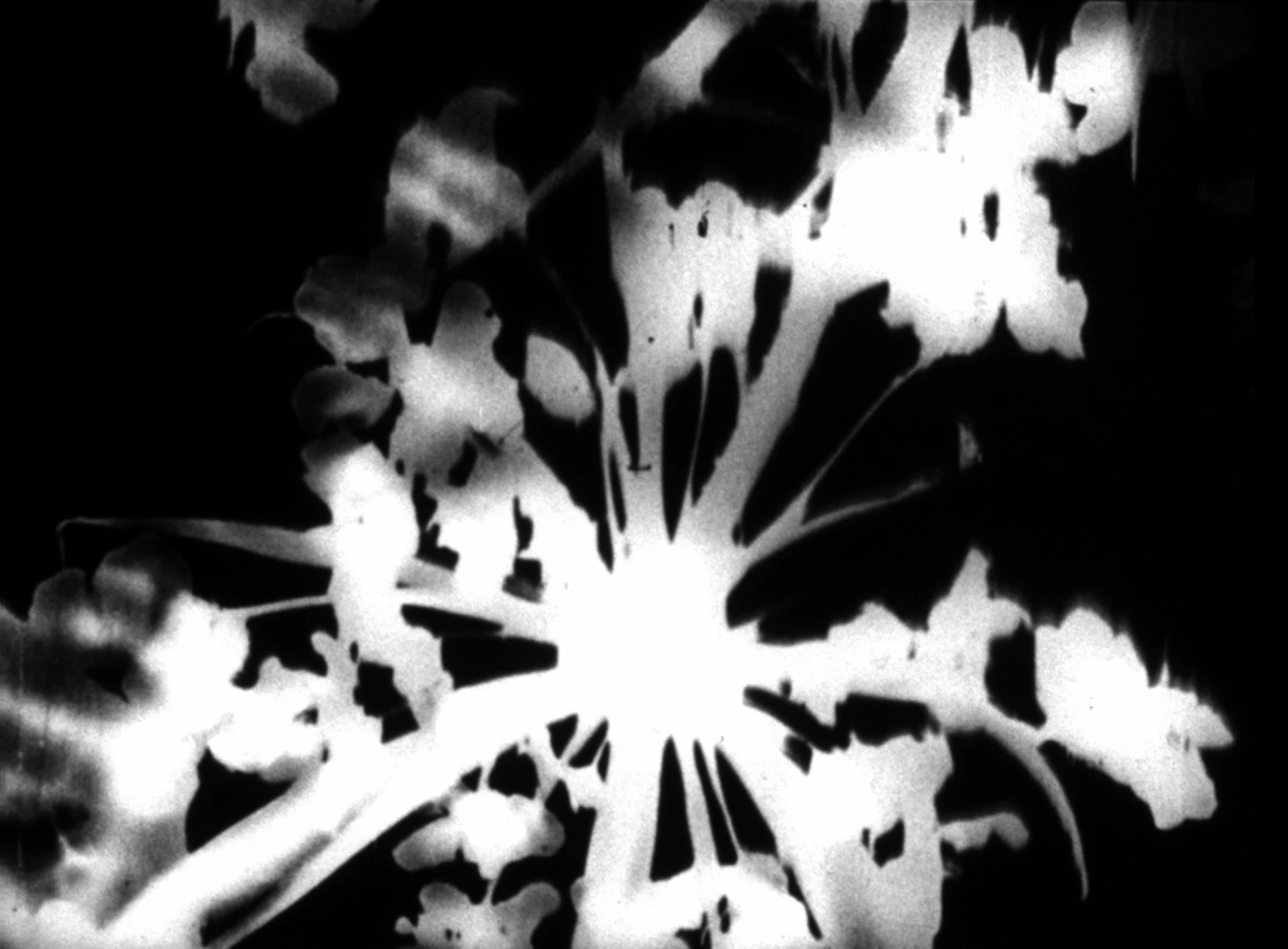
![Pirates des Lentillères, Une île et une nuit [Una isla y una noche], 2023, película](https://recursos.museoreinasofia.es/styles/large_landscape/public/Actividades/celuloide_activismo_3.jpg.webp)

Actividad dentro de la programación...
Cinema Commons
Cinema Commons is a research, programming and publishing project which explores how film and sound experiences articulate interpretive communities, fostering collective debate and devising proposals for common spaces. Constructed in two annual editions, this year it will explore three core strands: the alternative film society as a place of utopia and resistance, with film curators Miriam Martín and Ana Useros; the work of artist Christian Nyampeta and the École du soir, a learning collective focused on African diaspora and inspired by the trailblazing Senegalese film-maker Ousmane Sembène; and the union between activism and celluloid, machine and poetry, in the L’Abominable Laboratory, located on the outskirts of Paris.
The project addresses processes of socialisation and film’s potential beyond the image, with this edition bringing together different practices which explore film’s capacity to assemble and produce common spaces, understood in architectural, social and political terms. Film has always been a decisive tool in struggles for emancipation and, setting out from this genealogy, the proposals in this edition look to understand the role it can play in today’s cultural and political context, overcoming the dominant forms of representation and its modes of distribution to advance towards an ethics of life in common.
Ver programa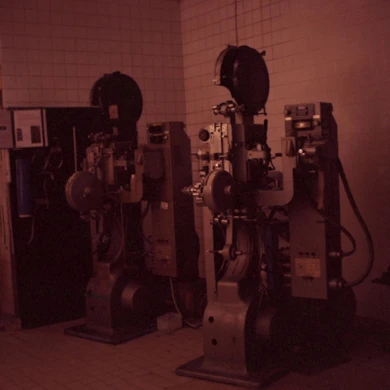
Long Live L’Abo! Celluloid and Activism
4, 5, 6 DIC 2025
The third instalment of Cinema Commons, a research, programming and publishing project which explores how film articulates interpretive communities, fosters collective debate and devises proposals for common spaces, presents L’Abominable, an artist- and film-maker-run independent film-lab founded in 1996 on the outskirts of Paris. The programme is structured around three sessions: a lecture-workshop on L’Abominable, conducted by film-makers Pilar Monsell and Camilo Restrepo; a session of short films in 16mm produced in L’Abominable; and the feature-length film Une île et une nuit (An Island and One Night), made by the Les Pirates des Lentillères collective.
Better known by the shortened version of L’Abo, the artist-run laboratory emerged in response to disappearing infrastructures in artisan film-making and endeavours to offer the creative community a self-managed space in which to produce, develop and screen films in analogue formats such as Super8, 16mm and 35mm. With this underpinning, L’Abo champions the aesthetic and political experimentation of analogue cinema opposite digital hegemony.
L'Abominable, more than a simple work tool, has become a space of artistic and social exchange which has knitted together a community. It is characterised by endowing technique with a poetic dimension, in a community that manufactures its own film devices, and situates pedagogy at its core — the film-makers and artists train one another on common ground. Further, it seeks to forge an opening to all experimental languages around celluloid, for instance installation and film performance, while constituting a place of preservation and conservation in the history of the medium.
L'Abominable is an example of how, at the height of the digital age, artists and film-makers are recovering cinematography and vindicating the production process in its entirety. This autonomy invents alternative routes in the industry as it creates new tools, develops other forms of expression and explores unknown cinematic territories.
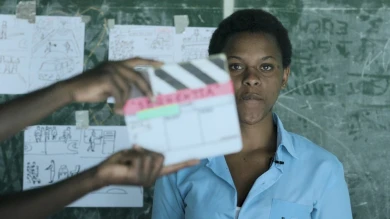
Christian Nyampeta and the École du soir
13, 14, 15 NOV, 11, 12, 13 DIC 2025
This second instalment of Cinema Commons, a research, programming and publishing project which explores how film articulates interpretive communities, fosters collective debate and devises proposals for common space, comprises three sessions with Rwandan artist, musician and film-maker Christian Nyampeta and Ècole du soir. The programme’s first session screens video works made by Nyampeta, while the second sets forth a dialogue on the creative processes of Ècole du soir. The third brings proceedings to a close with the screening of a film selected by the artist: Ousmane Sembène’s Guelwaar (1992).
The work of Christian Nyampeta encompasses pedagogies and community forms of knowledge production and transmission. His Ècole du soir (Evening School) is an art project conceived as a mobile space of collective learning and is named in homage to Ousmane Sembène (1923–2007), a pioneer of African cinema who defined his films as “evening classes” for the people, a medium of education and emancipation through culture.
The New York-based artist from Rwanda uses art and museums to create spaces of encounter and common learning that predate colonial education models. Via popular culture frames of reference like comics, music and film, Nyampeta develops dynamics and spaces from which to build experiences which redress the wounds of diaspora and its consequences; further, his work recovers, makes visible and heals — through a pedagogical and artistic process — the social divides of the African people. With Ècole du soir he also works on creations without authorship and uses the counter-ethnographic legacy of novelist and film-maker Ousmane Sembène as a tool to deconstruct the Western view of Africa.
Más actividades

Oliver Laxe. HU/هُوَ. Dance as if no one were watching you
Tuesday, 16 December 2025 – 7pm
As a preamble to the opening of the exhibition HU/هُوَ. Dance as if no one were watching you, film-maker Oliver Laxe (Paris, 1982) engages in conversation with the show’s curators, Julia Morandeira and Chema González, touching on the working processes and visual references that articulate this site-specific project for the Museo Reina Sofía. The installation unveils a new programme in Space 1, devoted from this point on to projects by artists and film-makers who conduct investigations into the moving image, sound and other mediums in their exhibition forms.
Oliver Laxe’s film-making is situated in a resilient, cross-border territory, where the material and the political live side by side. In HU/هُوَ. Dance as if no one were watching you, this drift is sculpted into a search for the transcendency that arises between dancing bodies, sacred architectures and landscapes subjected to elemental and cosmological forces. As a result, this conversation seeks to explore the relationship the piece bears to the imagery of ancient monotheisms, the resonance of Persian Sufi literature and the role of abstraction as a resistance to literal meaning, as well as looking to analyse the possibilities of the image and the role of music — made here in collaboration with musician David Letellier, who also works under the pseudonym Kangding Ray — in this project.
These inaugural conversations, part of the main working strands of the Museo’s Public Programmes Area, aim to explore in greater depth the exhibition narratives of the shows organised by the Museo from the perspective of artists, curators and specialists.
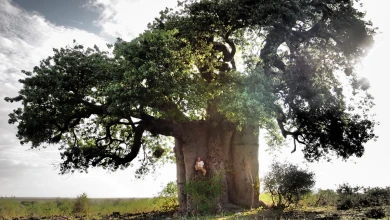
Francisco López and Barbara Ellison
Thursday, 11 December - 8pm
The third session in the series brings together two international reference points in sound art in one evening — two independent performances which converse through their proximity here. Barbara Ellison opens proceedings with a piece centred on the perceptively ambiguous and the ghostly, where voices, sounds and materials become spectral manifestations.
This is followed by Francisco López, an internationally renowned Spanish sound artist, who presents one of his radical immersions in deep listening, with his work an invitation to submerge oneself in sound matter as a transformative experience.
This double session sets forth an encounter between two artists who, from different perspectives, share the same search: to open ears to territories where sound becomes a poetic force and space of resistance.

Long Live L’Abo! Celluloid and Activism
4, 5, 6 DIC 2025
The third instalment of Cinema Commons, a research, programming and publishing project which explores how film articulates interpretive communities, fosters collective debate and devises proposals for common spaces, presents L’Abominable, an artist- and film-maker-run independent film-lab founded in 1996 on the outskirts of Paris. The programme is structured around three sessions: a lecture-workshop on L’Abominable, conducted by film-makers Pilar Monsell and Camilo Restrepo; a session of short films in 16mm produced in L’Abominable; and the feature-length film Une île et une nuit (An Island and One Night), made by the Les Pirates des Lentillères collective.
Better known by the shortened version of L’Abo, the artist-run laboratory emerged in response to disappearing infrastructures in artisan film-making and endeavours to offer the creative community a self-managed space in which to produce, develop and screen films in analogue formats such as Super8, 16mm and 35mm. With this underpinning, L’Abo champions the aesthetic and political experimentation of analogue cinema opposite digital hegemony.
L'Abominable, more than a simple work tool, has become a space of artistic and social exchange which has knitted together a community. It is characterised by endowing technique with a poetic dimension, in a community that manufactures its own film devices, and situates pedagogy at its core — the film-makers and artists train one another on common ground. Further, it seeks to forge an opening to all experimental languages around celluloid, for instance installation and film performance, while constituting a place of preservation and conservation in the history of the medium.
L'Abominable is an example of how, at the height of the digital age, artists and film-makers are recovering cinematography and vindicating the production process in its entirety. This autonomy invents alternative routes in the industry as it creates new tools, develops other forms of expression and explores unknown cinematic territories.
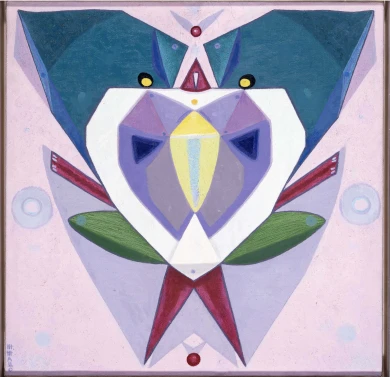
Estrella de Diego Lecture. Holding Your Brain While You Sleep
Wednesday, 3 December 2025 – 7pm
Framed inside the Museo Reina Sofía’s retrospective exhibition devoted to Maruja Mallo, this lecture delivered by Estrella de Diego draws attention to the impact of the artist’s return to Spain after her three-decade exile in Latin America.
Committed to values of progress and renewal in the Second Republic, Mallo was forced into exile to Argentina with the outbreak of the Civil War and would not go back to Spain to settle definitively until 1965 — a return that was, ultimately, a second exile.
Mallo saw out her prolific artistic trajectory with two impactful series: Moradores del vacío (Dwellers of the Void, 1968–1980) and Viajeros del éter (Ether Travelers, 1982), entering her most esoteric period in which she drew inspiration from her “levitational experiences” of crossing the Andes and sailing the Pacific. Her travels, both real and imaginary, became encounters with superhuman dimensions.
In parallel, her public persona gained traction as she became a popular figure and a key representative of the Generation of ‘27 — the other members of which also started returning to Spain.
This lecture is part of the Art and Exile series, which seeks to explore in greater depth one of the defining aspects of Maruja Mallo’s life and work: her experience of exile. An experience which for Mallo was twofold: the time she spent in the Americas and her complex return to Spain.
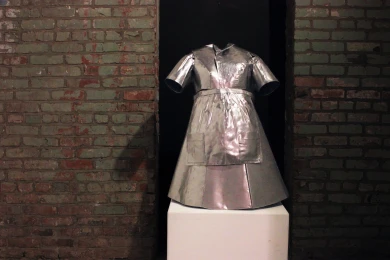
Haunting History
Friday, 28 November 2025 – 6pm
Curator Patricio Majano invites writer Elena Salamanca, artist Beatriz Cortez and artist and writer Olivier Marboeuf to explore, in conversation, the political agency of artistic forms in relation to the spectral resonances in Central America, the Caribbean, and their diasporas.
Central America is a region inhabited by spectres that continually interrupt any attempt at historical closure. Five centuries of colonisation, counterinsurgency wars, genocides, dictatorships and deportations have resulted in accumulated traumas and persistent forms of violence that still move around under the surface of the present. More than past ruins, these spectres are material forces which persist, invade and reclaim the reparation and reconfiguration of the frameworks of historical legibility. In Central American artistic practice, these spectral presences become method, counter-archive and counter-pedagogy.
Taking El Salvador as both axis and prism, this conference seeks to think about “ghostliness”, not as a metaphor but as a political and aesthetic technology, from the following questions: How is that which persists beyond disappearance manifested? Who speaks from amputation? How does memory operate when the State apparatus has systematically searched for its erasure? How is the spectral tapped into as a form of resistance? Which conditions and methods allow art to articulate a claim, reparation and justice when hegemonic narratives are upheld in denial?
Over the course of 2025, these questions have articulated the research residency of Salvadoran curator Patricio Majano in the The Cáder Institute of Central American Art (ICAC) by virtue of the project Amputated Identities: Ghosts in Salvadoran Art. Majano’s research traces genealogies and resonances between Salvadoran contemporary art, the Indigenous genocide of 1932 and the Civil War (1980–1992), interrogating how these unresolved forms of violence operate with artistic subject matter.
Beyond a closing act of the ICAC residency, this encounter stresses exchange and dialogue as method: opening the process and sharing questions, tensions and unresolved challenges — not as conclusions, but as work in progress.



![Miguel Brieva, ilustración de la novela infantil Manuela y los Cakirukos (Reservoir Books, 2022) [izquierda] y Cibeles no conduzcas, 2023 [derecha]. Cortesía del artista](https://recursos.museoreinasofia.es/styles/small_landscape/public/Actividades/ecologias_del_deseo_utopico.jpg.webp)
![Ángel Alonso, Charbon [Carbón], 1964. Museo Reina Sofía](https://recursos.museoreinasofia.es/styles/small_landscape/public/Actividades/perspectivas_ecoambientales.jpg.webp)